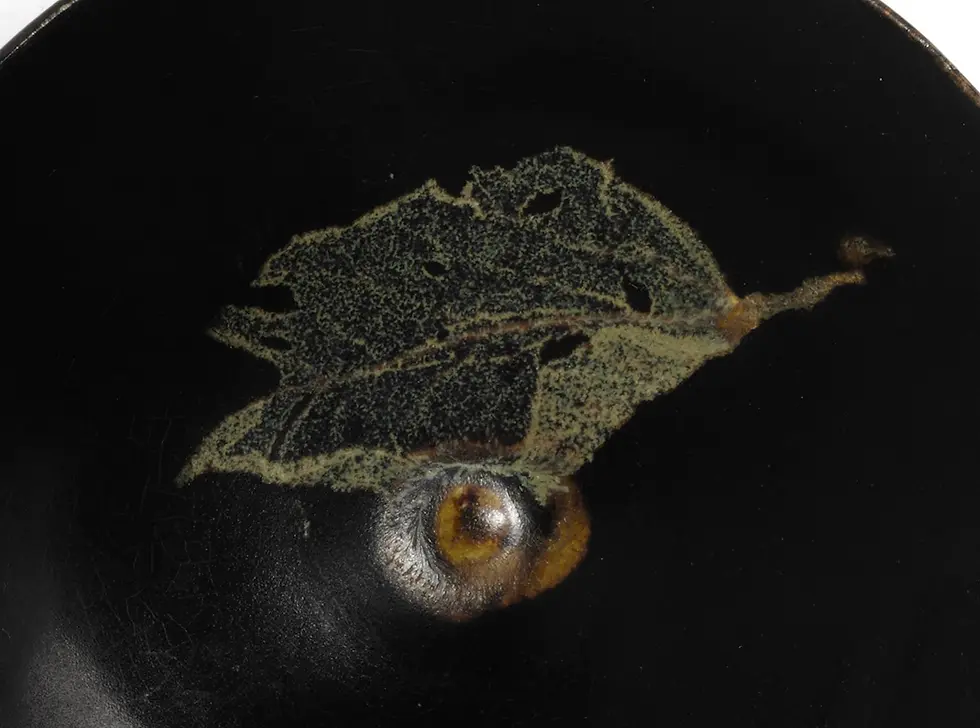宋代筆記 vol.66 青山居76.5萬港元南宋吉州窰黑釉木葉天目茶盞(修復)- A Superb Jizhou Black-Glazed 'Leaf' Bowl Southern Song Dynasty, Surface Retouched and Repaired.
- SACA
- Jul 12, 2024
- 5 min read
Updated: Feb 9
吉州窯木葉茶碗存世完整甚少,藏家對品項的容忍度也比其他宋瓷品種要高。上一期SACA學會介紹了臨宇山人的木葉茶碗(修復)在2018年拍出35000美金。2020年蘇富比專場,僅僅是兩年時間(Monochrome II 9 October 2020)另一件修復件拍出76.5萬港元。
這兩件器物的修復手法相似,都是商業修復噴塗。優點是看不出修復的痕跡,即使是用紫光燈照射,也因為噴塗而隱去原來的痕跡,除非拆開重新修復,不然無法確認修復的程度、是否缺肉等問題。另外一個比較重要的問題就是噴塗後的觸感,會失去原先釉面的感覺。宋瓷的一大收藏亮點就是難以用言語表述的觸感,這類修復方法利弊平衡是未來藏家需要考量的要點。
傳統的日本茶道中使用的修復方法是大漆修復,通常沒有隱藏修復的程度,另一方面,也可以在茶道中繼續使用,繼續傳承。大漆修復(kintsugi)的傳世唐物茶碗在日本各大博物館均有收藏,也同時包括三千家的收藏(裏千家、表千家、武者小路千家)。
從茶人的角度,大漆修復更為合適;從普通藏家角度,商業修復更為完整,但近年來隨著茶道的盛行,相信進步神速的藏家會開始理解茶道中的殘缺美,還有其實用性。
Few Jizhou leaf tea bowls have survived in perfect condition, and collectors have a higher tolerance for items than for other Song porcelain varieties. The previous issue of the SACA Society featured a leaf tea bowl (restored) by LinYuShanren that fetched $35,000 in 2018. another restored piece fetched $765,000 at Sotheby's in 2020, just two years later (Monochrome II 9 October 2020).
The restoration method of these two objects is similar, as they were both commercially restored and sprayed. The advantage is that no traces of restoration can be seen, and even when illuminated with a violet light, the original traces are hidden under the layers of spraying, making it impossible to ascertain the extent of restoration and whether or not there is any missing fragments unless the piece is taken apart and restored again. Another problem is that the original glaze will be concealed under the spray paint and hence lost its tactile quality after spraying. One of the highlights of collecting Song porcelain is the indescribable tactility of the glaze, and the balance between the pros and cons of this type of restoration is an important point for future collectors to consider.
The traditional method of restoration used in the Japanese Tea Ceremony is kintsugi (lacquer) restoration, which usually does not hide the extent of the restoration. Moreover, it can also be used in the Tea Ceremony to continue the legacy of the piece. The kintsugi (lacquer restoration) example of Heirloom Karamono tea bowls can be found in major museums and in the collection of the School of Teas by Sen no Rikyu. (裏千家, 表千家, 武者小路千家).
From the perspective of a tea master, kintsugi is more appropriate; from the perspective of an ordinary collector, commercial repair seem more presentable, but in recent years, with the popularity of the tea ceremony, I believe that collectors who have made rapid progress will begin to understand the beauty of the remnants of the tea ceremony, as well as its practicality.
臨宇山人 木葉盞(修復)
PROPERTY FROM THE AOYAMA STUDIO COLLECTION 青山居珍藏
A SUPERB JIZHOU BLACK-GLAZED 'LEAF' BOWL SOUTHERN SONG DYNASTY | 南宋 吉州窰黑釉木葉天目茶盞
October 9, 03:06 PM JST
Estimate
600,000 - 800,000 HKD
Lot Sold
756,000 HKD
Property from the Aoyama Studio Collection
A SUPERB JIZHOU BLACK-GLAZED 'LEAF' BOWL
SOUTHERN SONG DYNASTY
青山居珍藏
南宋 吉州窰黑釉木葉天目茶盞
of conical shape, covered with a lustrous brownish-black glaze thinning at the rim, decorated on the interior with a worm-eaten leaf, forming an attractive honey-brown silhouette, the foot left unglazed revealing the pale body, Japanese wood box
15.5 cm, 6 ⅛ in.
Condition Report
There has been retouching to the surface, probably to conceal flaking and an area of restoration.
Provenance
A Japanese private collection, Tokyo.
日本東京私人收藏
Catalogue Note
The Jizhou kilns at Yonghezhen, Ji'an county in Jiangxi province, a region formerly called Jizhou, were not blessed with the finest raw materials for making stonewares, but came up with the most original ideas for decorating. They were unique in exploiting the chemical composition of real tree leaves for making tea bowls with most naturalistic – because natural – silhouette leaf designs.
See a related bowl illustrated in Gugong Songci tulu. Longquan yao, Geyao ji qita ge yao/Illustrated Catalogue of Sung Dynasty Porcelain in the National Palace Museum. Lung-ch'üan Ware, Ko Ware and Other Wares, Taipei, 1974, pl. 72; and another bowl from the collection of Alfred Clark, included in Ryūsen Shūhō / Mayuyama, Seventy Years, Tokyo, 1976, vol. I, pl. 677, and sold in our London rooms, 11th May 2011, lot 3.












Comments